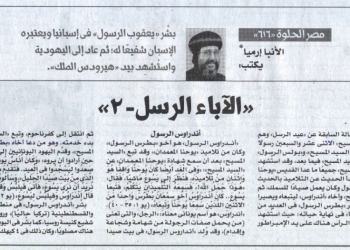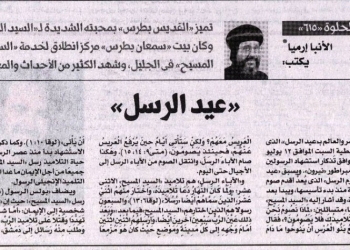In the previous articles, we spoke of Egypt under the Romans. We ended at Empress Pulcheria, sister of Theodosius II and her husband Marcian (450-457 A.D.) We shall resume our talk about that epoch in Egypt.
Owing to Pulcheria’s wisdom and knowledge, she was chosen Empress. Thus, she was the first woman to rule the Roman Empire, after which she married Prince Marcian and made him co-emperor. However, he ruled alone after her death for four years until he died and, thus, ending the reign of Emperor Theodosius in the East. He was succeeded by Leo I.
Caesar Leo I
Leo was of Dacian origin. He served in the Roman army. The eastern Roman patriarch, Aspar, and the army commander for he was respected by everybody. Leo was able to polarize the people and princes. Some thought that he would be easy to control. However, Leo’s power and independence from Aspar continued to increase, which gave rise to a conflict between them and eventually led to the murder of the patriarch. In fact, the coronation ceremony marked the beginning of the patriarch’s interference in the state’s affairs.
Having settled down, he reconciled with the Ostrogoths to please the patriarch who helped him ascend the throne. This resulted in his marrying off his daughter to Zeno who became Emperor later. Aspar tried to assassinate Zeno, but failed.
Leo, however, made some mistakes which threatened the Empire’s internal stability. Historians maintain that during Leo’s tenure, Byzantium was influenced by the Western Roman Empire. Also, the Huns tried to topple Constantinople, but failed due to her strong fortification. Moreover, the Vandals tried to fail the extension of the empire. They failed, too. In fact, the Vandals attacked the Greek coast, after which Leo made a peace treaty with Genseric. It is said he got to know of the patriarch’s treason, so he killed him and the entirety of his family. By the end of his tenure, he became quite unpopular until he died in 474. He was succeeded by Leo II, also known as the Sicilian.
Leo II (467-474 A.D.)
Some historians maintain that Leo II was Leo’s eldest grandson, the son of his daughter who was married to Zeno, a prince of Anatolia. His grandfather made Leo II rule with him, then named him heir apparent. At that time, he was seven years old. Leo, however, died a year after enthronement owing to an unknown ailment. He was succeeded by his father Zeno. A rumor spread that Leo’s death was not natural, and his mother was accused of poisoning him so her husband might become emperor. Some historians do not count Leo an emperor due to the shortness of his tenure and infancy.
Zeno (474-491 A.D.)
Zeno was a commander of the Roman troops in Isuaria. He was the emperor’s son-in-law, then prince regent to Leo II, which is why he succeeded the latter. Some old records mention that in 464, Zeno was able to seize some letters written by Ardabur to his father Aspar in which he encouraged the Sassanid king to invade the Roman Empire. Thus, he produced these letters to Leo I who, in turn, banished Ardabur who was commander of the army. He appointed Zeno comes Exorbicum and commander of the army, which boosted the latter’s influence. In 465, a great conflict took place between Leo and Aspar due to the increase of Zeno’s influence as he became the emperor’s friend and ally.
In 466, Zeno married the emperor’s daughter. In 467, he fathered the heir apparent, Leo II. In 468, Zeno was miraculously saved from Aspar’s attempt to kill him, which is why he fled from Constantinople and stayed away for two years. At that time, Aspar was able to extend his influence, making his son Julius Petreseus Caesar and married him off to Leo’s youngest daughter in 470. Yet, on the following year, Leo executed Aspar and Ardabur. On the following day, Zeno returned to Constantinople.
In 473, Leo appointed his grandson, Leo II, Caesar. He died in 474. As we mentioned beforehand, Zeno became prince regent due to his son’s infancy, after which he became emperor. No sooner had he taken over, than he had to settle down the situation with the Vandals who threatened his sea trade routes and raided the empire’s coastal cities. He succeeded in making a peace treaty with them, having paid the ransom of the Roman prisoners. In spite of this success, Zeno was unpopular with his subjects and senate: for he became emperor owing to marrying the emperor’s daughter. Leo I’s wife had instigated great sedition in an attempt to dethrone him, and appoint another with the help of her brother Basiliscus.
At that time, the conspirators spread riots in Constantinople. Party heads accused him of foolishness, weakness, and inability to rule, which made him flee to Anatolia in 475. Basiliscus took over. During Zeno’s first term, he cared for Christianity, and issued the Henotikon (instrument of union). Yet, historians believe that this decree caused conflicts, schisms and tribulations.
No sooner had conspirators got rid of Zeno, than they started conflicting. Basiliscus usurped the throne. He imposed huge taxes on the people due to lack of money. Also, a great fire broke out, only to eat up most of the city and make the people cast more blame on him.
Then, the senate secretly endorsed Zeno. Also, some Roman squads supported him to restore the country’s affairs. So, Basiliscus mobilized an army led by his nephew to fight Zeno which he was able to attract by money and promises. As Zeno approached Constantinople, Basiliscus realized his failure. So, he sought refuge in Hagia Sofia Cathedral.
In 476, Zeno entered Constantinople, after which he banished Basiliscus and his family to Cappadocia where they died owing to being imprisoned in a dry well.
No sooner had Zeno restored the throne than he became despotic. He was so unfair he that ignored what the Ostrogoths did, and fought them fiercely. Then, he coerced all the princes who engaged in sedition against him. Having done so, he became increasingly profane. So much so that the people hated him, and two ancient historians maintain that he was buried alive! Zeno witnessed the annihilation of the Roman Empire from the West. He was succeeded by Anastasius I.
Concerning Egypt, Marcian became upset by her people. The Council of Chalcedon was held in 451 when Pope Dioscorus, the twenty-fifth patriarch, was terribly persecuted for rejecting the emperor’s opinion. So much so that he was banished; so he had to appoint a priest in his stead. Some historians assert that Marcian wanted to get rid of the Pope of Alexandria in order to punish the Egyptians who considered the Roman Empire their enemy. Yet, they revolted against the emperor’s decision. The priest was killed during Leo I’s tenure who appointed another patriarch endorsed by Zeno.
This led to the continuation of conflicts in Egypt: for Egyptians would never accept any archpriest, save the Pope of Alexandria who they choose. Such religious conflicts were backed by the Roman Emperors who did not heed the people’s will, which made the Egyptians oppose the Roman rule. Stories will never end in Beautiful Egypt.
General Bishop
Head of the Coptic Orthodox Cultural Center


 العربية
العربية











